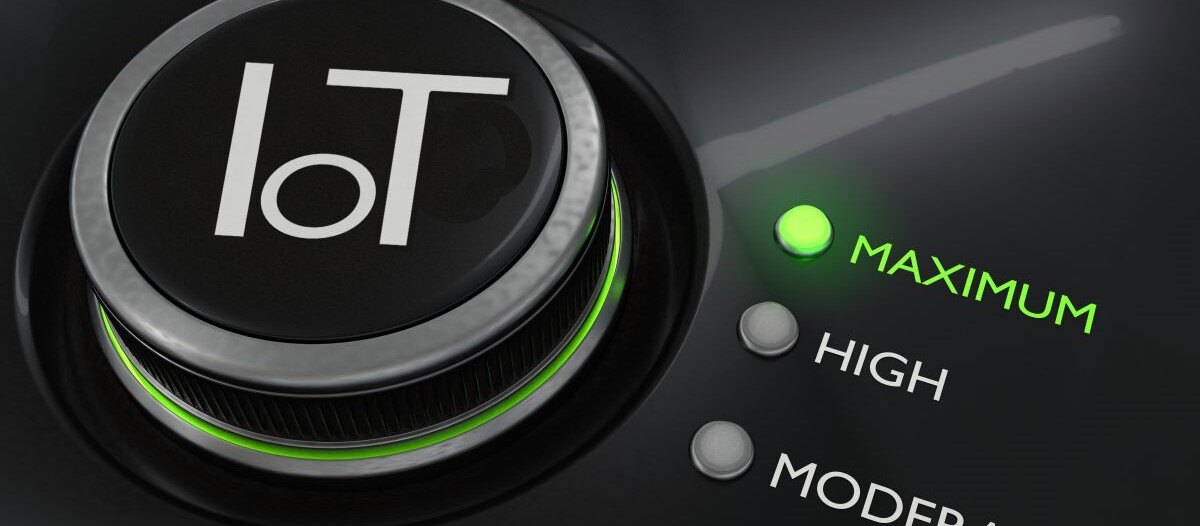From Implementation to Maximization
Getting the most out of IoT in the workplace

Many flexible and hybrid workplaces are well equipped when it comes to Internet of Things (IoT) devices, with an array of solutions helping monitor occupancy, administer space reservations and help achieve greater sustainability. But is optimum value being extracted from these systems? When making any business decision, organizations always choose the option with the strongest returns. Why would the return of investment (ROI) on workplace IoT be any different?
To truly extract maximum value, it requires a shift in mindset of team members who inhabit the workplace. Where IoT and other solutions have been deployed in workplaces, when not initially executed well — or the tech chosen was lackluster — it has caused long-term distrust in the very systems trying to improve working environments.
Facility managers must question whether they are really making the most of the tech they have adopted in the workplace; and if not, where can they address the loss of faith in the capabilities, as well as bridging multigenerational teams who interact with these systems in different ways.
The state of IoT in the workplace
IoT devices are now a firm fixture in modern workplaces, acting as an integral part of organizations' digital transformation strategies. Bridging the gap between the online and offline, they streamline communication between the two. Naturally, they have found applications in various areas within workplaces, including FM, asset tracking, employee productivity and safety, and environmental monitoring.
IoT devices have been particularly useful when deploying integrated workspace management systems (IWMS), revealing themselves as indispensable tools in FM’s belts. FMs are leveraging IoT devices to monitor and control various aspects of their facilities, such as lighting, HVAC and security systems. These devices can collect real-time data on energy usage, occupancy levels and security events, enabling organizations to optimize resource consumption, reduce costs and enhance safety and security.
As organizations reach advanced stages of their deployments, the focus moves onto maximization. There is still room to optimize IoT devices within the workplace to extract further value, but this is not without a fresh set of challenges, including:
- Poor workplace habits: When the digital transformation of the workplace was kicked into top gear, many FMs were still testing the water with a range of IoT solutions for better managing space reservations. Some went great, some not so. Bad habits were formed, such as employees not booking a room through the designated system and simply sitting in whatever space was free, throwing everyone else off kilter. The result was a loss of faith in the systems designed exclusively to help people find and reserve the spaces they needed.
- Interoperability and integration: As the number of IoT devices in workplaces increases, interoperability and integration among different devices and systems becomes increasingly important. Organizations must ensure different IoT devices can communicate with each other seamlessly and integrate with existing IT systems and processes to fully realize the benefits of IoT.
- Scalability and manageability: Managing many IoT devices and data can be complex and challenging. Organizations need robust systems in place to scale their IoT deployments and manage devices effectively, including device provisioning, monitoring, maintenance and updates.
- ROI and business value: While IoT devices have the potential to deliver significant benefits, organizations need to carefully assess the ROI and the business value of IoT deployments. This includes considering the costs of implementation, maintenance, and data management, as well as quantifying the tangible and intangible benefits of IoT devices in the workplace.
How can FMs right those wrongs and maximize their IoT to extract greater value?
The first step is always the hardest. To regain the confidence of employees with workspace systems and get employees on board (or back onboard), FMs must have a sound strategy.
Provide clear and consistent communication about the availability, location and features of meeting rooms and workspaces. A system that can display real-time information on interactive maps, digital signage or mobile devices can help employees find and book the most suitable spaces for their needs. Pure software solutions, while good on a tight budget, quickly falter at this step. Leveraging IoT solutions like panels can erase any question of availability. The user could go to the panel app or ask reception about the space, but the visual cue of green for available and red for booked (like a traffic light system) makes it immediately clear.
Interoperability is not merely flavor of the month; it is a timeless classic. Employ a meeting room booking system that is easy to use, reliable and secure. A system that can integrate with other tools such as calendars, email and smart building solutions can simplify the reservation process and avoid errors or conflicts. With that in mind, it pays off to choose IoT that comes without proprietary software, which typically faces all sorts of integration issues.
Encourage feedback and suggestions from employees on how to improve the meeting room and workspace booking system. A system that can collect and analyze data on space utilization, employee preferences and satisfaction can help FMs identify issues and opportunities for improvement.
To maximize IoT, choose with purpose
Communication is everything. Creating a purposeful IoT solution requires understanding the intention and goal for the initiative. Adding IoT to a client’s solution stack will not help without a clear outline of the data they need and the problems they are trying to solve. Holding stakeholder discussions, understanding their competing priorities and commonalities is crucial. If it is visibility they need, an IoT solution can help. If it is efficient space usage, IoT can capture and report on the data. If it is ease of use, the right IoT paired with a great employee experience workflow is out there. Likewise, compatibility with existing infrastructure and current and soon-to-be-deployed workplace tools is essential. Finally, considering the whole-life cost, rather than only the initial investment, can help make better informed cost/benefit analysis and raise the ROI.
Lastly, as Gen Z enters the workforce, it is important to adopt systems that appeal to employees, no matter their age. The user experience should be prioritized, and devices should be intuitive, easy to understand and require minimal training. Meanwhile, interfaces should be clean, simple and accessible with consideration given to varying levels of tech familiarity. Working style can be considered: younger generations may be more accustomed to mobile devices and want to reserve space through an app, while older generations may prefer booking via a desktop calendar or an on-the-spot solution, such as a panel to book without delay. Neglecting any single age group risks not maximizing returns on IoT investments.
Building and following best practices come hand in hand with maximized ROI
While the adage states that people should live in the moment, planning is equally imperative. Defining goals and objectives, identifying the challenges that need solving and their expected outcomes, followed by a metric by which to measure is key. Likewise, choose the right IoT devices and solutions. What functions and features are needed now, and what will be needed in the future? Will everything still be compatible down the line?
Building on that, interoperability should always be front of mind. Proprietary solutions can hamstring even the best laid plans when two systems are unable to communicate. Will software and hardware systems integrate off the shelf? Will an Open API approach be used? Silos persist and success is stunted. Choosing nonproprietary IoT – that which can be integrated with a range of other solutions – can head off this challenge and ensure devices can go on being used for years to come.
Finally, think beyond just the tech. It is important to consider the human aspect when deploying workplace technology to get the most out of it, otherwise features and capabilities can go unused due to lack of awareness or a hesitation of the new and unknown. It can provide freedom and flexibility allowing focus on more strategic and meaningful tasks, while optimizing process through reducing manual and time-consuming operations. Contrarily, it can pose risks such as those of privacy, security, ethics and well-being. When pursuing maximization, IoT must be used in a responsible, human-centric way.
A lesson in what’s worked
A major international financial organization found their return-to-office initiative a challenge at its London headquarters. Staff attending the office found smaller meeting rooms were unavailable, making collaboration challenging.
The client decided to deploy room sensors to supplement existing IoT to learn more. After three months of data collection a few key facts were discovered:
- Smaller meeting rooms were being booked for senior staff visiting the office, just in case a suitable desk in the right location was unavailable. Key booking criteria included quiet, a good view and lower people flow.
- Staff collaboration sessions were booked in small meeting or client rooms rather than collaboration booths.
- Smaller rooms were booked for the whole day but typically used for less than two hours, leaving the room vacant and unbookable most of the day.
Sensor data identified the issues and integration with meeting room software helped identify the staff that help with their space use. Based on the data collected, the organization took several successful actions:
- Auto bump rules were applied to all small room bookings. If a room was not used by 10 a.m. and used for at least two hours, the booking was cancelled. This released more than 40 percent of previously booked blocked space.
- Small meeting rooms in collaboration areas were made bookable for only two-hour blocks using a compact room panel. This encouraged staff to book more appropriate space at the outset.
- All meeting rooms were supplied with sensors. If a room was not occupied, the space was released and the booker notified by email. Some larger meeting rooms with low utilization rates were converted into smaller meeting rooms.
Data-driven decision making was key to securing workplace change and effective space management. The combination of room sensors, panels and booking software provided an effective and maximized IoT solution. The granular level capture of by-the-minute-room use solved the meeting space shortage issue. This kind of clear data then made it easier to secure staff and leadership support to re-purpose space. The organization reconfigured space to increase the right room availability and team collaboration.
IoT is well entrenched within workplaces. The next step is to optimize for success. By acknowledging that user habits may need adjusting, assessing and reassessing changing goals, and understanding why total integration and interoperability are vital, it paves the way for realizing maximum value in the systems that have come to be relied upon run fluid and effective modern workplaces.


Natalie Appleton is vice president, Americas at NFS Technology. She is enthusiastic about finding effective workspace solutions. During her 16 years at NFS, Appleton has helped more than 120 clients across the legal, financial, health care and other industries transform their workspace technology and improve their employee experience.
Read more on Finance & Business , Project Management and Technology
Explore All FMJ Topics









